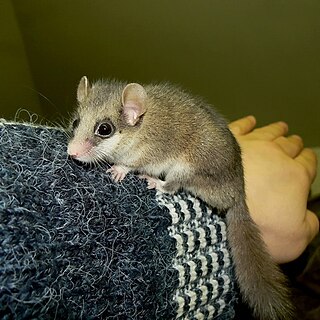
A dormouse is a rodent of the family Gliridae. Dormice are nocturnal animals found in Africa, Asia, and Europe. They are named for their long, dormant hibernation period of six months or longer.

Dryomys is a genus of dormouse. Collectively the members of the genus are referred to as forest dormice, although the type species also goes by the common name forest dormouse.

The woolly dormouse is a species of rodent in the family Gliridae endemic to Turkey.

The Japanese dormouse is a species of rodent in the family Gliridae endemic to Japan. It is the only extant species within the genus Glirulus. Its natural habitat is temperate forests. In Japanese, it is called yamane. Among dormice, it has the special ability of running at great speed upside down, suspended from branches. Its main food is fruit, insects, berries, nuts, and even flowers. It tends to inhabit arboreal nesting sites to avoid interspecific competition with the small Japanese field mouse because of their sympatric relationship.
The Angolan African dormouse is a species of rodent in the family Gliridae. Found in central and north Angola and western Zambia, it has been recorded from seven localities over an altitudinal range from 1,000 to 2,000 m above sea level. Its natural habitat is tropical dry forests. Although the population size is unknown, it is thought to be generally uncommon.
Christy's dormouse is a species of rodent in the family Gliridae. It is found in Cameroon and Democratic Republic of the Congo. Its natural habitat is subtropical or tropical moist lowland forests.
Jentink's dormouse is a species of rodent in the family Gliridae. It is found in Cameroon, Ivory Coast, Ghana, Liberia, Nigeria, and Togo, and possibly Benin, Equatorial Guinea, and Sierra Leone. Its natural habitat is subtropical or tropical, moist lowland forests.
Kellen's dormouse is a species of rodent in the family Gliridae. It is native to tropical Africa where its range extends from the Gambia and Senegal to Kenya and Tanzania. Its natural habitats are subtropical or tropical dry forests, and moist or dry savannah.
The Lorrain dormouse is a species of rodent in the family Gliridae. It is found in Cameroon, Democratic Republic of the Congo, Ghana, Guinea-Bissau, Liberia, Nigeria, Sierra Leone, Tanzania, and Uganda. Its natural habitats are subtropical or tropical, moist, lowland forests, moist savanna, and plantations.

The woodland dormouse is a species of rodent in the family Gliridae. It is native to southern and eastern Africa and is also known as the African dormouse, African dwarf dormouse, African pygmy dormouse, or colloquially as micro squirrel. Found in limited numbers in the pet trade, it has complicated care requirements compared to other pet rodents. Its natural habitats are subtropical or tropical, moist montane forests and rivers.
The Nagtglas's African dormouse is a species of rodent in the family Gliridae. It is found in Cameroon, Central African Republic, Ghana, Liberia, Nigeria, Sierra Leone, and possibly Gabon. Its natural habitat is subtropical or tropical, moist, lowland forests. The rodent is named after Cornelis Nagtglas.
The silent dormouse is a species of rodent in the family Gliridae. It is found in Cameroon, Democratic Republic of the Congo, Equatorial Guinea, and Gabon. Its natural habitat is subtropical or tropical moist lowland forests.
The masked mouse-tailed dormouse is a species of rodent in the family Gliridae. It is found in Iran and Turkmenistan.

The desert dormouse is a species of rodent in the dormouse family, Gliridae. This species was formerly placed in its own family, Seleviniidae, but it is now considered to be a dormouse, monotypic within the genus Selevinia. It is endemic to Kazakhstan.

Leithiinae is a subfamily of dormice. It is named after the Leithia, an extinct genus of giant dormouse from the Pleistocene of Sicily.

The forest dormouse is a species of rodent in the family Gliridae found in eastern Europe, the Balkans and parts of western Central Asia. It is categorized as being of least concern in the IUCN List of Threatened Species due to its wide range and stable population trend. Forest dormice have a diploid count (2n) of 48 chromosomes. Even though this species lives in a variety of geographic locations, its greatest population density is in the forests of central Moldova, in Transcaucasia, and in the mountains of Central Asia. In most other locations, population density of this species is rather low. Population density is dependent on many factors. But the main features that this species depends on for choosing a location are the presence of the appropriate food sources as well as good foliage that can be used for a habitat. The reason why the forests in central Moldova have the highest population density is they provide the largest diversity of food sources which are available throughout the year. This location also provides the best type of foliage for the forest dormice to build their nests as well as swing from branches. The combination of both of these aspects allows for this species to have its highest needs met. Therefore, during mating season they produce offspring who also stay in the same general area when they mature. It makes sense not to move from an area if it is providing for your most basic needs.
Walter Verheyen's African dormouse is a monotypic species of rodent in the family Gliridae. From the Central Congolian lowland forests ecoregion in the central Congo Basin, it has been found in west-central Democratic Republic of the Congo, in the vicinity of the Lukenie River and of Wafania, near the left bank of the Luilaka River. Although not found in immediate association, Lorraine's dormouse and the short-eared African dormouse are understood to be "broadly sympatric". Most closely resembling Jentink's dormouse, it differs from this species both in its much smaller size and in its relative proportions. On the IUCN Red List, its conservation status has been assessed as Data Deficient.






